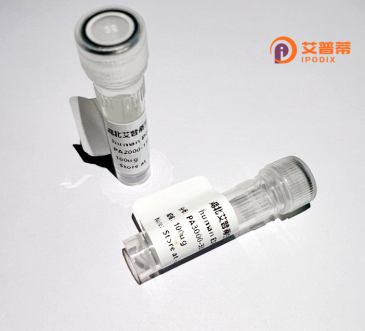
| 纯度 | >90%SDS-PAGE. |
| 种属 | Human |
| 靶点 | HIRA |
| Uniprot No | P54198 |
| 内毒素 | < 0.01EU/μg |
| 表达宿主 | E.coli |
| 表达区间 | 1-1017aa |
| 氨基酸序列 | MKLLKPTWVNHNGKPIFSVDIHPDGTKFATGGQGQDSGKVVIWNMSPVLQEDDEKDENIPKMLCQMDNHLACVNCVRWSNSGMYLASGGDDKLIMVWKRATYIGPSTVFGSSGKLANVEQWRCVSILRNHSGDVMDVAWSPHDAWLASCSVDNTVVIWNAVKFPEILATLRGHSGLVKGLTWDPVGKYIASQADDRSLKVWRTLDWQLETSITKPFDECGGTTHVLRLSWSPDGHYLVSAHAMNNSGPTAQIIEREGWKTNMDFVGHRKAVTVVKFNPKIFKKKQKNGSSAKPSCPYCCCAVGSKDRSLSVWLTCLKRPLVVIHELFDKSIMDISWTLNGLGILVCSMDGSVAFLDFSQDELGDPLSEEEKSRIHQSTYGKSLAIMTEAQLSTAVIENPEMLKYQRRQQQQQLDQKSAATREMGSATSVAGVVNGESLEDIRKNLLKKQVETRTADGRRRITPLCIAQLDTGDFSTAFFNSIPLSGSLAGTMLSSHSSPQLLPLDSSTPNSFGASKPCTEPVVAASARPAGDSVNKDSMNATSTPAALSPSVLTTPSKIEPMKAFDSRFTERSKATPGAPALTSMTPTAVERLKEQNLVKELRPRDLLESSSDSDEKVPLAKASSLSKRKLELEVETVEKKKKGRPRKDSRLMPVSLSVQSPAALTAEKEAMCLSAPALALKLPIPSPQRAFTLQVSSDPSMYIEVENEVTVVGGVKLSRLKCNREGKEWETVLTSRILTAAGSCDVVCVACEKRMLSVFSTCGRRLLSPILLPSPISTLHCTGSYVMALTAAATLSVWDVHRQVVVVKEESLHSILAGSDMTVSQILLTQHGIPVMNLSDGKAYCFNPSLSTWNLVSDKQDSLAQCADFRSSLPSQDAMLCSGPLAIIQGRTSNSGRQAARLFSVPHVVQQETTLAYLENQVAAALTLQSSHEYRHWLLVYARYLVNEGFEYRLREICKDLLGPVHYSTGSQWESTVVGLRKRELLKELLPVIGQNLRFQRLFTECQEQLDILRDK |
| 分子量 | 138.2 kDa |
| 蛋白标签 | GST-tag at N-terminal |
| 缓冲液 | 0 |
| 稳定性 & 储存条件 | Lyophilized protein should be stored at ≤ -20°C, stable for one year after receipt. Reconstituted protein solution can be stored at 2-8°C for 2-7 days. Aliquots of reconstituted samples are stable at ≤ -20°C for 3 months. |
| 复溶 | Always centrifuge tubes before opening.Do not mix by vortex or pipetting. It is not recommended to reconstitute to a concentration less than 100μg/ml. Dissolve the lyophilized protein in distilled water. Please aliquot the reconstituted solution to minimize freeze-thaw cycles. |
以下为关于重组人HIRA蛋白的3篇参考文献,包含文献名称、作者及摘要内容概括:
1. **文献名称**:*"The HIRA histone chaperone complex subunit UBN1 is necessary for human neural crest stem cell formation"*
**作者**:Lorberbaum et al. (2018)
**摘要概括**:研究利用重组人HIRA蛋白复合体探讨其在人类神经嵴干细胞分化中的作用,发现HIRA通过与UBN1等亚基互作,介导组蛋白H3.3的沉积,调控关键发育基因的表达。
2. **文献名称**:*"Structural basis of HIRA cochaperone function in the histone H3.3 assembly pathway"*
**作者**:Bowman et al. (2021)
**摘要概括**:通过解析重组人HIRA蛋白与伴侣蛋白ASF1a的复合物晶体结构,揭示了HIRA在H3.3组蛋白沉积中的分子机制及与染色质重塑因子的协同作用。
3. **文献名称**:*"The histone chaperone HIRA maintains mitochondrial dynamics and function via regulation of nuclear-encoded mitochondrial genes"*
**作者**:Sriranganathan et al. (2020)
**摘要概括**:利用重组HIRA蛋白及敲除模型,证实HIRA通过表观遗传调控线粒体相关基因(如TFAM)的表达,影响线粒体形态和功能,为HIRA在代谢疾病中的作用提供证据。
以上研究均涉及重组人HIRA蛋白的应用,涵盖发育调控、结构机制及疾病关联领域。
The human HIRA (Histone Cell Cycle Regulator) protein is a conserved histone chaperone critical for chromatin remodeling and epigenetic regulation. It plays a central role in depositing the histone variant H3.3 into chromatin independently of DNA replication, particularly in transcriptionally active regions, telomeres, and sites of DNA damage. HIRA interacts with multiple partners, such as UBN1 and CABIN1. forming the HUCA complex to facilitate H3.3 incorporation, thereby influencing gene expression, cellular differentiation, and development.
Dysregulation of HIRA is linked to developmental disorders (e.g., DiGeorge syndrome) and cancer, underscoring its importance in maintaining genomic stability and cellular identity. Recombinant human HIRA protein, generated via expression systems like *E. coli* or mammalian cells, retains these functional properties, enabling in vitro studies of chromatin dynamics, histone exchange mechanisms, and nucleosome assembly. Its applications span basic research—elucidating epigenetic inheritance, cell cycle-dependent chromatin remodeling, and DNA repair pathways—as well as drug screening for therapies targeting epigenetic abnormalities. By providing a purified, active form of HIRA, recombinant technology accelerates mechanistic insights into its role in health and disease, bridging molecular biology and translational medicine.
×